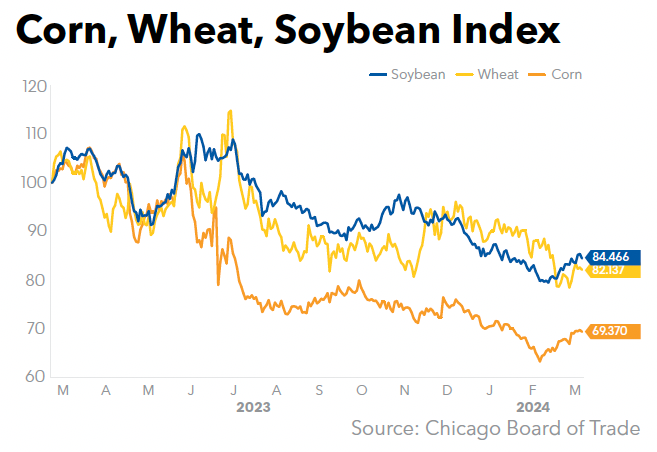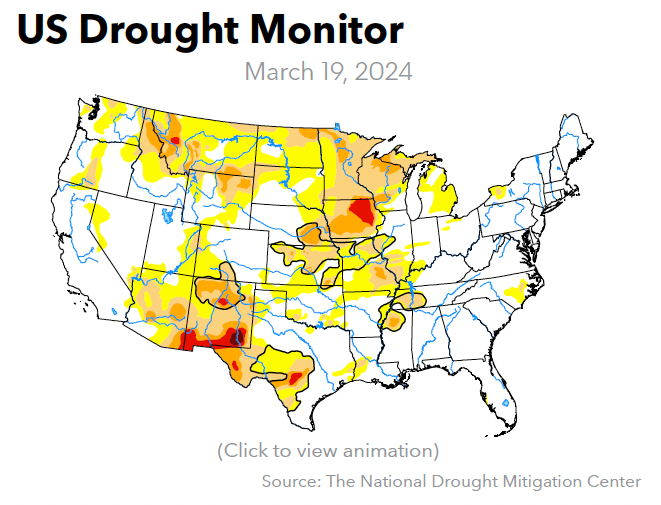Eastern Cornbelt:
Cooler temperatures moved into the Eastern Cornbelt as the week progressed, with highs slipping closer to seasonal norms after a stretch of warm mid-March days.
A winter weather advisory was in effect for northern Illinois and southern Wisconsin on March 21-22, with forecasts warning of 2-6 inches of snow in some locations. More precipitation was in the weekend forecast and likely to drift southward, slowing preplant ammonia applications in parts of central Illinois.
Highs in the 40s and 50s were reported across Indiana at midweek, with some locations seeing 60-degree readings as the week progressed. Temperatures in central Ohio were lower, falling to the upper-30s and low-40s as a cold front ushered in rains late in the week and into the weekend.
An Ohio source late in the week reported “some P&K and wheat topdress nitrogen going on, along with some pasture spreading as growers try to beat the next wave of rain coming in tomorrow evening.”
Western Cornbelt:
Warm, spring weather prevailed over Nebraska for much of the week, with highs reaching the 60s in central and southern areas of the state and up to the 70s in western Nebraska.
Northeastern areas of Nebraska were expecting a mix of rain and snow on March 22, but the heavier accumulation was aimed at northeastern Iowa, where weather advisories warned of 2-6 inches of snow on March 22.
Iowa sources reported a busy week for spring fieldwork and fertilizer application. “We have been busy and prices have moved up as most were not ready for the early open-season,” said one Iowa contact early in the week.
California:

After experiencing dry weather for most of the week, California was bracing for a wet weekend as storms move in from the Pacific.
Rain was expected to start in the San Francisco Bay Area and Sacramento on March 22 before reaching Southern California on March 23-24. While up to an inch was possible in Northern California, southern areas of the state were expecting a half-inch at most. Higher elevations in the Sierra Nevada were expecting 12-18 inches of snow from the system.
The state of the Sierra Nevada snowpack was close to the historical average as of March 20, ranging from 114% in the north to 92% in the south, or 101% overall, according to the California Department of Water Resources.
Pacific Northwest:
Record highs in the mid-70s and even low-80s were reported across western Washington at mid-month. Parts of Oregon also notched or tied some daily records early in the week, including a high of 80 in Hermiston.
Unseasonably mild weather was also reported across Montana and Idaho for most of the week, with highs reaching the low-60s. Cooler weather was on tap for the coming weekend, however. Both Seattle, Wash., and Portland, Ore., were expecting several rounds of drenching rain on March 22-23 as part of a Pacific weather system moving into the region.
Western Canada:
Multiple high temperature records were set across British Columbia early in the week, while parts of Alberta were hit with heavy snow at midweek. The weather was described as clear and crisp across much of Saskatchewan and Manitoba late in the week.
Southern Alberta had been expecting a potentially early start to spring fieldwork after a run of warm, dry days. The winter storm that hit western and southern Alberta on March 20-21 dropped as much as 10-30 cm of snow, however, prompting snowfall warnings from Environment Canada at midweek.
Snow and cooler temperatures also hit southern Saskatchewan during the week, where sources said spring fieldwork is likely to start on April 15-20 this year.
